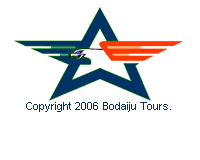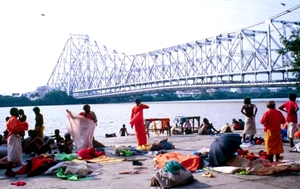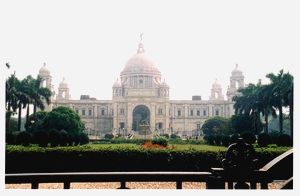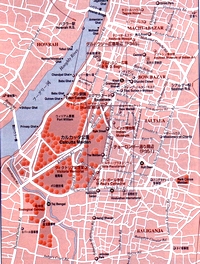

Bodaiju Tours (P) Ltd.

................................................
>> TRAVEL TOOLS
Copyright 2006 Bodaiju Tours (P) Ltd. All Rights Reserved.
>> SPECIAL TOURS
Kolkatta Guide Book
Kolkata (previously known as Calcutta) is one of the largest cities in the world and is the capital city of the Indian state of West Bengal lying at 22°30’ N and 88.°30’ E.
The former capital of British India, the port of Kolkata today forms the commercial and industrial hub of eastern India located on the banks of the Hooghly River (about 150 km upstream from the Bay of Bengal).
The main part of the city is sandwiched between the river, part of the world's largest deltaic zone at the mouth of the river Ganges, on the west, the salt lakes to the east and the famous Sunderban mangrove forests, marshes and swamps to the south.
To the first time visitor, Kolkata is indeed overwhelming. It presents a unique blend of 19th century Europe and the throbbing vitality of a metropolis of teeming millions. Densely populated and polluted, Kolkata is often an ugly and desperate place, that to many, sums up the worst of India. Yet it's also one of the country's more fascinating centres producing some of India's finest literature, theatre, films, art and culture and has some scenes of rare beauty and interesting architecture.
During the British Raj, Kolkata was known as the Jewel of the East and was the capital of the country till 1911. It still bears the Victorian imprint on its streets and structures. Today, it is still the most important city in the east, the nerve center of trade and industry of the State.
Economically, however Kolkata is suffering: the port has been silting up, making navigation from Kolkata down to the sea steadily more difficult and limiting the size of ships that can use the port. Electrical power in Kolkata is so on-again off-again that virtually every hotel, shop or small business has to have some sort of standby power generator or battery lighting system.
Despite all these problems Kolkata is a city with a soul and amongst the squalor and confusion is a place of sheer magic. You can see and experience the majestic sweep of the Maidan; the arrogant bulk of the Victoria Memorial; the superb collection of archaeological treasures exhibited in the Indian Museum and meet many fascinating people from all walks of life. Here quaint trams trundle down narrow streets amidst jostling crowds spilling over from the pavements and hand-drawn rickshaws trundle past laden with everything from goods to tourists. All of this awaits your discovery.
In sharp contrast is Kolkata 's pride, the Underground Metro Rail Service, which is India's first and one of the world's most modern, presently running between Esplanade and Tollygunge. For the shopper, Kolkata offers some of the best bargains to be found in the country such as clothing, leather goods, as well as trivia and exotica. Transport costs are still among the lowest in India. As for food, the bewildering variety available on offer is matched by the most reasonable prices. Indeed, Kolkata is as much a haven for tourists traveling on a shoe-string as it is for big budget tourists.
Numerous hotels, including several of international class, offer comforts and conveniences to suit every budget, cuisines to please every palate. There are also Clubs in the finest British tradition such as Bengal Club, Calcutta Club, Calcutta Cricket & Football Club and Saturday Club, to name a few. On the other hand, the essence of Bengali and Indian culture is evident in several landmarks located across the city.
Whatever your fancy, Kolkata has something for everyone and you are sure to have an interesting time while here.
Climate
Kolkata has uniform temperatures throughout the year ranging from 12-27°C in the winter and 24-38°C in the summer. Annual rainfall is around 160 cm. The humidity level can be very high in the summer and can make one's life difficult especially if you are unused to these damp heat conditions. Cotton clothing is ideal for the summer months whereas light woollens are required for the winter.


Contact for more information
>> WHAT'S NEW?
Dubai Package tours
Sri Lanka Package tour
Nepal Package tour
Maldives Package tour
Flight Over the world
Private Jet
